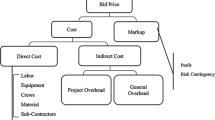Abstract
Risk management focusses on the identification of uncertainties and its impacts associated with various functional activities carried out to achieve various mandates, goals and objectives of the company. To assess the risk level (as ‘very high’, ‘high’, ‘medium’ or ‘low’), consequences and likelihood analysis are to be done based on the judgmental knowledge and experiences of the participants. The traditional methods of risk classification are time consuming and laborious if the inputs are voluminous. In this study, the hazards occurring in different sections of underground mining have been categorized, and associated risks have been predicted using different machine learning modelling techniques, namely KNN, SVM, logistic regression and decision tree by keeping the prescribed guidelines of the DGMS intact and using it as the basic building blocks to model the machine learning classification models.










Similar content being viewed by others
Availability of data and material
Data are collected from a mine and are available with the corresponding author. It will be shared if needed by the reviewers, but cannot be published.
Code availability
Full python code available with the corresponding author and can be shared if needed by the reviewers, but cannot be published.
References
L. Khandu (2020) Safety risk assessment and management in mining industry. B.Tech. Thesis, NIT, Rourkela, Spring, 2020
S.J. Butani, Relative risk analysis of injuries in coal mining by age and experience at present company. J. Occup. Accid. 10(3), 209–216 (1988)
C. Allanson (2002) Strata control in underground coal mines: A risk management perspective,Proceedings of the 2002 Coal Operators' Conference, Mining Engineering, University of Wollongong,135–153
J. Joy, Occupational safety risk management in Australian mining. Occup. Med. 54(5), 311–315 (2004)
A. Ionica, E. Edelhauser, S. Irimie (2007) Quality risk management–An integrated approach in the mining industry. Fascicle of Management and Technological Engineering, Annals of the Oradea University, Volume VI (XVI), 1941–1946
D. Komljenovic, W.A. Groves, V.J. Kecojevic, Injuries in US mining operations–A preliminary risk analysis. Saf. Sci. 46(5), 792–801 (2008)
Z.A. Md-Nor, V. Kecojevic, D. Komijenivic, W. Groves, Risk assessment for haul truck-related fatalities in mining. Min. Eng. 60(3), 43–49 (2008)
J.M. Patterson, S.A. Shappell, Operator error and system deficiencies: analysis of 508 mining incidents and accidents from Queensland, Australia using HFACS. Accid. Anal. Prev. 42(4), 1379–1385 (2010)
S. Bahn, Workplace hazard identification and management: the case of an underground mining operation. Saf. Sci. 57, 129–137 (2013)
Juuso, E. K. & Koistinen, A. H. (2015).Decision support for risk management in mining industry, MMEA WP5. 2.7, Mining Deliverable D5. 2.7. 3
D.P. Tripathy, C.K. Ala, Risk assessment in underground coal mines using fuzzy logic in the presence of uncertainty. J. Inst. Eng. India Ser. D 99(1), 157–163 (2018)
S. Abbasi, Defining safety hazards & risks in mining industry: a case-study in United States. Asian J. Appl. Sci. Technol. (AJAST) 2(2), 1071–1078 (2018)
T. Vlachos (2018). Certifiable risk management & business continuity approach in mining industry. In Proceedings of the 4th World Congress on Mechanical, Chemical, and Material Engineering (MCM'18), DOI (Vol. 10).MMME 108
S. Sarkar, S. Vinay, J. Maiti (2016). Text mining based safety risk assessment and prediction of occupational accidents in a steel plant. In 2016 International Conference on Computational Techniques in Information and Communication Technologies (ICCTICT), IEEE, 439–444
S. Sarkar, S. Vinay, R. Raj, J. Maiti, P. Mitra, Application of optimized machine learning techniques for prediction of occupational accidents. Comput. Oper. Res. 106, 210–224 (2019)
X. Xie, G. Fu, Y. Xue, Z. Zhao, P. Chen, B. Lu, S. Jiang, Risk prediction and factors risk analysis based on IFOA-GRNN and apriori algorithms: application of artificial intelligence in accident prevention. Process Safety Environ. Protec. 122, 169–184 (2019)
E.Y. Boateng, J. Otoo, D. Abaye, Basic tenets of classification algorithms K-nearest-neighbor, support vector machine, random forest and neural network: a review. J. Data Anal. Inform. Process 8(4), 341–357 (2020)
P.C. Sen, M. Hajra, M. Ghosh, Supervised classification algorithms in machine learning: A survey and review, in Emerging Technology in Modelling and Graphics. (Springer, Singapore, 2020), pp. 99–111
R. Boutaba, M.A. Salahuddin, N. Limam, S. Ayoubi, N. Shahriar, F. Estrada-Solano, O.M. Caicedo, A comprehensive survey on machine learning for networking: evolution, applications and research opportunities. J. Internet Serv. Appl. 9(1), 1–99 (2018)
B. Xi, H. Gu, H. Baniasadi, D. Raftery, Statistical Analysis and Modeling of Mass Spectrometry-Based Metabolomics Data (Humana Press, New York, Methods Mol. Biol., 2014), pp. 333–353
A. Agresti, C.R. Mehta, N.R. Patel, Exact inference for contingency tables with ordered categories. J. Am. Stat. Assoc. 85(410), 453–458 (1990)
Y. Sasaki, The Truth of the F-Measure (University of Manchester, Technical report, School of Computer Science, 2007)
V. Vovk (2015) The fundamental nature of the log loss function. In Fields of Logic and Computation II, Cham, Springer, ,307–31.
Funding
No Funding Sources for the completion of this work.
Author information
Authors and Affiliations
Corresponding author
Ethics declarations
Conflicts of interest
On behalf of all authors, the corresponding author states that there is no conflict of interest.
Additional information
Publisher's Note
Springer Nature remains neutral with regard to jurisdictional claims in published maps and institutional affiliations.
Rights and permissions
About this article
Cite this article
Tripathy, D.P., Parida, S. & Khandu, L. Safety Risk Assessment and Risk Prediction in Underground Coal Mines Using Machine Learning Techniques. J. Inst. Eng. India Ser. D 102, 495–504 (2021). https://doi.org/10.1007/s40033-021-00290-1
Received:
Accepted:
Published:
Issue Date:
DOI: https://doi.org/10.1007/s40033-021-00290-1




